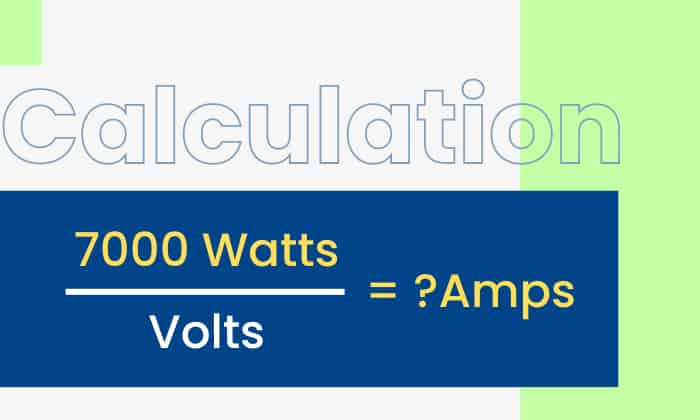If you want to know how many amps is 7000 watts in a common 120V setup, then the quick answer is 58.3 amps. That doesn’t account for the power factor and other voltages, though.
Read on for the full picture, so you can know once and for all how to convert amps to watts and vice versa.
Table of Contents
Calculating Amps From 7,000 Watts
The most straightforward way to calculate amps from an electrical power rating in watts is to use the formula:
\[\text{Amps} = \frac{\text{Watts}}{\text{Volts}}\]
You simply divide the watts by the voltage to get the current draw in amps. The voltage affects the calculation, so we’ll look at a few different scenarios:
1. DC Circuits
Let’s say, you have a 120-volt DC circuit. In this case, we don’t need to considerHow Many Amps is 7000 Watts – Galvin the power factor, and the conversion is as follows:
\[\frac{7000 \text{ watts}}{120 \text{ volts}} = 58.3 \text{ amps}\]
Here are other examples using different voltages.
| Voltage | Amps = 7000W / Volts |
| 12V | 7000 / 12 = 583A |
| 24V | 7000 / 24 = 292A |
| 48V | 7000 / 48 = 146A |
2. AC Circuits
The more common single-phase AC circuits need to account for the power factor (PF), so we arrive at the following formula instead:
\[\text{Amps} = \frac{\text{Watts}}{\text{Volts} \times \text{Power Factor}}\]
Assuming PF = 0.9, then at 220V:
\[\frac{7000 \text{ watts}}{220 \text{ volts} \times 0.9} = 35.4 \text{ amps}\]
In real-world terms, this could mean you have a 220V single-phase AC 7000-watt generator with 0.9 PF. That means it will draw around 35.4 amps of current.
Here is the amp chart based on various voltages, assuming the power factor is set at 1:
| Voltage | Amps = 7000W / (Volts x 1) |
| 120V | 7000 / 120 = 58.3A |
| 208V | 7000 / 208 = 33.65A |
| 220V | 7000 / 220 = 31.8A |
| 230V | 7000 / 230 = 30.43A |
| 240V | 7000 / 240 = 29.2A |
| 277V | 7000 / 277 = 25.27A |
| 347V | 7000 / 347 = 20.17A |
| 480V | 7000 / 480 = 14.58A |
| 600V | 7000 / 600 = 11.67A |
3. Three-Phase AC Circuits
For three-phase AC circuits, I use line-to-line or line-to-neutral voltage and account for the power factor.
For example, with 480V of line-to-line voltage and a power factor of 1:
\[\text{Amps} = \frac{7000 \text{W}}{480 \text{V} \times 1 \times \sqrt{3}} = 8.42\text{A}\]
If it’s a 277V line-to-neutral voltage and a PF of 1, then we get:
\[\text{Amps} = \frac{7000\text{W}}{277\text{V} \times 1 \times 3} = 8.42\text{A}\]
In the end, you wouldn’t have to do any of these manually with a watts to amps calculator, but I understand that most of those tools don’t always include the variables mentioned above.
Conclusion
How many amps is 7000 watts? While a quick answer might tell you 7000 watts equals 58.3 amps in a 120V setup, there’s often more to it.
This article delved into the nuances, exploring how voltage, power factor, and circuit types play crucial roles in converting amps to watts and vice versa. We saw the math for DC and AC circuits, both single-phase and three-phase, providing a clear understanding of the variables involved.
By learning these principles, you’re not just equipped to answer a specific question; you’ve gained the ability to confidently perform any watts-to-amps conversion, regardless of the voltage or circuit type.

I am Edwin Jones, in charge of designing content for Galvinpower. I aspire to use my experiences in marketing to create reliable and necessary information to help our readers. It has been fun to work with Andrew and apply his incredible knowledge to our content.

